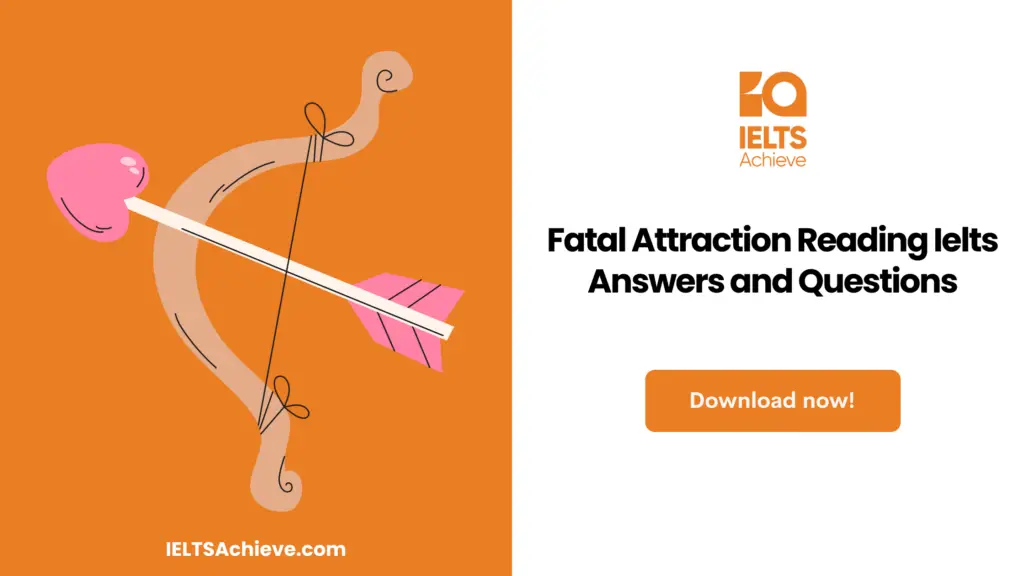The Blog post contains the following IELTS Reading Questions
- IELTS Reading sentence completion
- IELTS Reading matching features
- IELTS Reading matching heading questions
IELTS Reading Passage – Fatal Attraction

Fatal Attraction
During the mid-nineteenth century, Charles Darwin was the first to notice a flesh-eating plant. Biologists studying cells and DNA using 21st-century techniques are beginning to understand how these plants seek, eat, and digest, as well as how such strange adaptations evolved.
The venus flytrap plant’s leaves are covered in hairs. Their main function is to trigger a tiny electric charge, which travels down tunnels in the leaf and opens up pores in the leaf’s cell membranes. This process takes place when an insect brushes against them. The leaf rapidly flips in the shape from convex to concave, like a soft lens as water surges from the cells on the inside of the leaf to those on the outside. They snap together as the leaves flip, and trap the insect using its sharp-toothed jaws.
The setting of an underwater trap is a sophisticated method for bladderwort. It functions similarly to a tiny bag-like bladder, pumping water out while creating a vacuum within. When small creatures swim by, they bend their hairs on the bladder, causing a flap to open. The low pressure draws in water, dragging the animal along with it. The door swings shut again in one five-hundredth of a second. Meanwhile, the Drosera sundew has a thin, sweet liquid oozing from its leaves that attracts insects and then holds them fast before the leaves snap shut. Pitcher plants employ yet another strategy to entrap their prey, growing long tube-shaped leaves. Raffles pitcher plant, native to Borneo’s jungles, produces nectar that both attracts insects and forms a slick surface on which they cannot get a grip. Insects that land on the pitcher’s rim slide on the liquid and fall in.
The majority of carnivorous plants secrete enzymes in order to penetrate the hard exoskeleton of insects and absorb nutrients from within their prey. However, the purple pitcher plant, which lives in North American sides and infertile study soils, relies on other organisms to process its food. It supports an intricate food web of mosquito larvae, midges, and bacteria, many of which can only survive in this one-of-a-kind environment. The prey that falls into the pitcher is shredded by these animals, and the smaller organisms feed on the debris. Finally, the plant absorbs the nutrients that have been released.
Due to the fact that these plants thrive on being carnivorous, the benefits of consuming flesh are not what you might assume. Meat-eating animals, such as humans, utilise the carbon found in meat’s protein and fat to create muscle and store energy. In order to manufacture light-harvesting enzymes, carnivorous plants obtain nitrogen, phosphorus, and other essential elements from their prey. In other words, eating animals enables carnivorous plants to carry out photosynthesis, i.e., develop by directly absorbing energy from the sun.
In fact, carnivorous plants are extremely inefficient at converting sunlight into tissue. This is due to the amount of energy used to create the equipment used to catch animals, enzymes, pumps, and so on. A pitcher or a flytrap cannot do much photosynthesis because, unlike plants with ordinary leaves, they lack flat solar panels that can absorb a lot of sunlight. However, there are some circumstances in which the advantages of being carnivorous outweigh the disadvantages. Bog soil, for example, contains little nitrogen and phosphorus, giving carnivorous plants an advantage over plants that obtain these nutrients through more traditional means. Bogs are also flooded with sunlight, allowing even the most inefficient carnivorous plant to photosynthesise enough light to survive.
Evolution has made this trade-off numerous times. Certain scientists claim that when the DNA of carnivorous plants and other species is compared, they evolved independently on at least three separate occasions. Certain carnivorous plants appear to be the same but are only distantly related. The tropical genus Nepenthes and the North American genus Sarracenia are two types of pitcher plants that surprisingly evolved from different ancestors, despite the fact that both have deep pitcher-shaped leaves and use the same strategy for prey capture.
Scientists can see the evolution of complex carnivorous plants from simpler ones in a variety of cases. Venus flytraps, for example, are related to Portuguese sundews, which catch prey passively through ‘flypaper’ glands on their stems. They are related to Drosera sundews, which can also curl their leaves over their prey. The Venus flytrap appears to have evolved a more complex version of this type of trap, complete with jaw-like leaves.
Unfortunately, the adaptations that allow carnivorous plants to thrive in arid environments also make them exceptionally sensitive. Agricultural runoff and pollution from power plants are increasing nitrogen levels in many North American bogs. Carnivorous plants are so finely tuned to low levels of nitrogen that the extra fertiliser overloads their systems, causing them to burn out and die.
Humans endanger carnivorous plants in other ways as well. Botanists are keeping the location of some rare species hidden because the black market trade in exotic carnivorous plants is so active. Even if poaching of carnivorous plants is stopped, they will continue to face other threats. The increased suppression of fires in North Carolina’s savannah is allowing other plants to grow too quickly and outcompete the flytraps in their native environment. Perhaps this is good news for flies. But it’s a loss for others who enjoy the sheer inventiveness of evolution, as Darwin did.
Fatal Attraction Reading Questions
Questions 14-17
Look at the following statements (Questions 14-17) and the list of plants. Match each statement with the correct plant, A, B, C, D OR E. write the correct letter A, B, C, D, or E in boxes 14-17 on your answer sheet.
14. It uses other creatures to help it digest insects.
15. It produces a slippery substance to make insects fall inside it.
16. It creates an empty space into which insects are stuck.
17. It produces a sticky substance which traps insects on its surface.
List of plants
A Venus flytrap
B bladderwort
C Drosera sundew
D Raffles pitcher plant
E purple pitcher plant
Improve your performance in Matching Features questions by clicking here to access our comprehensive guide. Learn how to match specific features or characteristics with the options provided in the IELTS Reading section.
Questions 18-21
Reading passage 2 has nine paragraphs, A-I. Which paragraph contains the following information?
18. A disadvantage of some carnivorous plants with leaf shapes is mentioned.
19. An example of a conservation effort for carnivorous plants.
20. The unexpected origin of some carnivorous plant information.
21. In the form of an example, changes in the environment shorten the life cycles of carnivorous plants.
Ready to conquer Matching Headings questions? Click here to learn essential tips and techniques for matching headings accurately to paragraphs or sections in the IELTS Reading section.
Questions 22-26
Complete the notes below. Choose NO MORE THAN TWO WORDS from the passage for each answer.
How a Venus flytrap traps an insect
A plant leaf is touched by an insect(22)___________.small (23)_____________passes through leaf (24)_____________ in the cell membrane open.Outside leaf cells are filled with (25)___________. The leaves change into a (26)________________ shape and snap nut.
Enhance your sentence completion skills in the IELTS Reading section. Click here to access our comprehensive guide and learn effective strategies for filling in missing words or phrases in sentences.
Unlock your full potential in the IELTS Reading section – Visit our IELTS Reading Practice Question Answer page now!
Recommended Questions:
Renewable Energy IELTS Reading Question with Answer
Fatal Attraction Reading Answers
14.E
15. B
16. B
17. B
18. E
19. I
20. F
21. H
22. Hairs
23. (electric) Charge
24. Pores
25. Water
26. Concave

We hope you found this post useful in helping you to study for the IELTS Test. If you have any questions please let us know in the comments below or on the Facebook page.
The best way to keep up to date with posts like this is to like us on Facebook, then follow us on Instagram and Pinterest. If you need help preparing for the IELTS Test, join the IELTS Achieve Academy and see how we can assist you to achieve your desired band score. We offer an essay correction service, mock exams and online courses.

